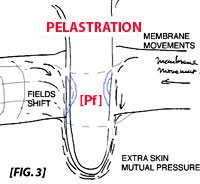|
|
|
The Theory of the Pelastrating Universe or the Big Tube Theory
A new process is to be described to explain gravitational fields.
This process is called: Pelastration. We note it as [P].
 |
|
Pelastration - a combination of 'penetration' and 'elastic' - is a process where an impact force penetrates an infinite stretchable flexible layer of a space and carries a part of that flexible layer as an additional outer skin during all his further trajectory.
In our Big Tube concept the impact force is a tube. This tube pelastrates another tube in three possible ways; (1) the impact tube goes only through the top layer(s) of the impact zone (the top of the tube that is hit) and the impact tube will follow a trajectory inside that tube, (2) the impact tube goes completely through the other tube, and carries then two layers as a new skin (Top and Bottom layer), (3) the impacting tube splits in two or more sub-tubes.
|
The multi-dimensional Universe consists of a giant basic tube made from a tensegritic membrane of gravitons (probably with a bucky-structure or nano-tube structures).
The Big Tube sub-divides itself by pelastration in trillions of other tube-zones and inter- and intra-dimensional tubes. First a number of basic tubes related to basic concepts and balance. Pelastration is an essential process to explain the creation of dimensions and several joining activities, but is not the only process. Sub-tubes - resulting from the pelastration of several types of tubes - can also coil, knot, etc. with other tubes and provoking changes of conditions. For example by coiling they can create temporary conditions (joined resonance by outside connection) to attract symbiotic other tubes (compare it with human reproduction). Another type of resonance is however also created by internal friction or over-heating of one or more layers in a tube-zone or the entry of new tubes (e.ge. adding new strings to the piano).
There are several types of pelastration, such as: self-pelastration (entering the own tube - to position inside or pass through)(check our interpretation of the Uroboros snake), pelastration from another tube, de-pelastration (internal tube leaving a dimension), etc.
Pelastration is bound to certain conditions related such as size, tension, polarity and the effect on the impact angles. The internal fields in tube may also influence the final behavior of the impact tube.
We can also point on the Pelastration-factor [Pf]: this is the mutual exchange of tension and friction of interacting tubes. The [P] joint of the two tubes can be seen as a type of mechanical valve. Pressure changes in one or both of the tubes will influence the size of the opening. This opening will be in some conditions a 'worm-gate' accessing a new dimension.
Of course pelastration is reversible due changing conditions (resonance of surrounding tubes, under-pressure in layers, changes in [Pf], etc. Reversed pelastration is called: depelastration
|
|
|
|
|
|
|
|